A hugely-credentialed exploration company with a $15m farm-out JV with Sandfire Resources over its Bryah Basin acreage. More recently it has acquired the advanced Sinclair nickel project from Glencore.
| Corporate Details | 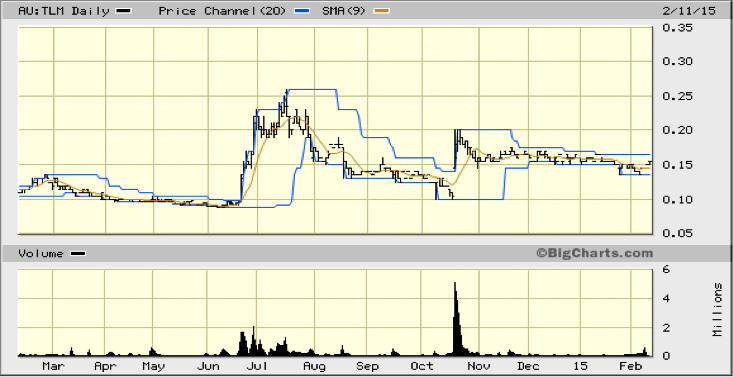 |
| Status: Emerging Producer | |
| Size: Small Cap | |
| Commodity Exposure: Nickel | |
| Share Price: $0.155 | |
| 12-month Range: $0.088 – $0.26 | |
| Shares: 132m, Options: 6m | |
| Top 20: 38% | |
| Net Cash: $15m | |
| Market Value: $20m |
| Key Parameters | Rating (✓out of 5) | Quarterly Statistics |
| Management Quality | ✓✓✓✓✓ | Q4 2014 Exploration Spend: $0.456m |
| Financial Security | ✓✓✓✓✓ | Q4 2014 Administration Spend: $0.292m |
| Project Quality | ✓✓✓✓✓ | Exploration Spend 60%, Admin. Spend 40% |
| Exploration / Resource Potential | ✓✓✓✓✓ | Q1 2015 Forecast Exploration Spend: $0.75m |
| Project Risk | ✓✓✓✓✓ | Q4 2015 Forecast Admin. Spend: $0.3m |
We introduced Talisman Mining to our Portfolio during January 2014, based on our long-standing belief in the company’s proven board and management team, together with its high-quality Bryah Basin project portfolio and robust cash position. The company has recently undertaken two significant corporate deals – the first involving a $15 million farm-out of its Bryah Basin acreage to Sandfire Resources (ASX: SFR) – and the second involving the acquisition of the Sinclair nickel operation.
Talisman boasts proven in-house exploration and appraisal expertise, comprising a large chunk of the former management team that was involved with hugely successful ASX-listed nickel explorer/producer, Jubilee Mines. The team was involved in the discovery of multiple high-grade, sulphide nickel deposits that transformed Jubilee into an established producer, prior to its eventual takeover by Xstrata. The Jubilee board accepted Xstrata’s $23-a-share cash offer during 2007 – a far cry from its minnow status at $0.20.
Talisman maintains a dominant and enormously prospective ground position within the Doolgunna region of Western Australia and has formulated a farm-out JV with Sandfire Resources, whereby Sandfire can earn up to a 70% stake in three of Talisman’s projects by spending at least $15 million over a 5½-year period. Talisman has also secured the advanced Sinclair nickel project from Glencore for $10 million, a project that Talisman’s board knows intimately, having been involved in its initial discovery.
Recent Activity
Talisman has provided an update on drilling and exploration activities within its Doolgunna Copper-Gold Projects in Western Australia, where its joint venture partner Sandfire Resources continues to progress a major exploration program – and has recently re-commenced drilling. Separately, Talisman has also confirmed the acquisition of the Sinclair project from Glencore.
Sinclair Project
Talisman announced during October that it has reached agreement to acquire the Sinclair Nickel Project from Xstrata Nickel Australasia Operations Pty Ltd, a subsidiary of Glencore. Consideration comprises a cash payment of $8 million payable at completion of the transaction (complete), along with a contingent deferred payment of $2 million if production recommences within six years of transaction completion.
Talisman will now commence the formal process of registering the transfer of the associated mining and exploration tenements with the Department of Mines and Petroleum, following which ground-based exploration activities can commence at Sinclair.
Technical Significance
As we’ve commented previously, the Sinclair deal is a major game-changer for Talisman, providing it with a major avenue towards production, which complements its exciting DeGrussa exploration activities.
Talisman hasn’t wasted any time as it pre-empted the Sinclair deal being successfully concluded, engaging external consultants to assist with the next steps in terms of exploration at the Skye and Stirling prospects, with a view to defining and confirming potential drill-targets. This work will include the creation of a three-dimensional geological model and a review of high-priority historical geophysical data in this near-mine area.
The massive nickel sulphide mineralisation at Skye and Stirling shows good down-plunge continuity with a strong electromagnetic (EM) response. Importantly, several strong late-time EM conductors remain to be tested for thicker and/or higher grade mineralisation beneath the Sinclair deposit. Talisman has engaged nickel geophysics specialists Newexco to review and validate high-priority EM targets, and to identify possible massive nickel sulphide targets relative to previous mineralised drill-holes.
In conjunction with the geophysical review, Talisman has also recently engaged geological consultants SRK to assist with the development of robust 3D models of the key rock types, mineralization and controlling structures at both Skye and Stirling. This 3D geological model is intended to enable Talisman to better constrain ore-bearing positions and to assist in facilitating accurate drill-hole targeting.

Elsewhere, the Delphi prospect and surrounding area hosts the southern continuation of the prospective Sinclair Ultramafic channel and has historically returned several nickel sulphide intersections in limited drilling over a strike length of at least 8km. The widespread distribution of heavily disseminated, stringer and, in some places, massive nickel sulphides highlights the prospectivity of the area, and Talisman is prioritising exploration activities at the Delphi prospect accordingly.
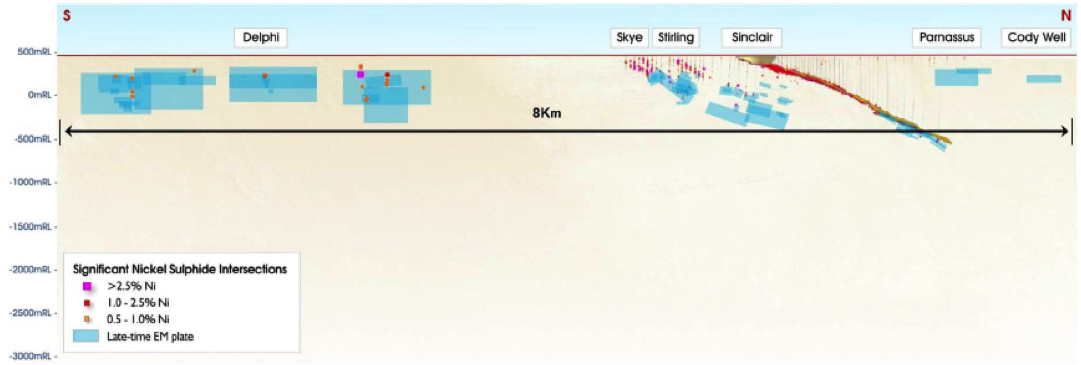
Talisman is currently reviewing the Delphi prospect data, whilst Newexco have been engaged to review geophysical data at the prospect. The objective of this combined review is to develop systematic exploration programs to gather further geological and geochemical data and to potentially test existing EM targets away from mineralised drill-holes at Delphi.
Finally, Talisman has engaged a consultant to evaluate the potential for JORC code (2012)-compliant resource estimates, based upon existing historical drilling, for both the Sinclair deposit mine area and the Sinclair deposit extension. Due to the complexity of the Sinclair ore body, definition drilling needs be closely-spaced in order to better define higher-grade shoots associated with tight folding and remobilised massive sulphide.
It is considered that the existing historical broadly-spaced drilling traverses across the mine extension position are wide enough apart to miss significant high-grade massive sulphide mineralisation. This has been demonstrated by the last four northern-most drill traverses which intersected high-grade mineralisation with grades greater than 2.5% Ni over widths of up to 6.34 metres and evidence that underground mining in some of the final mining levels yielded significant increases in mineralised volume compared with the geological model (as defined by surface diamond drilling).
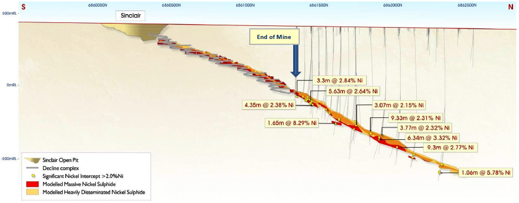
Given the above, it is possible that a JORC-compliant resource may not be possible at this time for the Sinclair extension. However, this could change with further infill drilling in the future.
Project Background
The Sinclair nickel deposit was discovered by the formerly highly successful nickel miner and explorer, Jubilee Mines, during October 2005. Sinclair is therefore an asset that Talisman knows extremely well, with several key members of its team (Brian Dawes, Alan Senior and Gary Lethridge) were closely involved in the project’s evaluation.
The Sinclair mine was developed and commissioned in 2008 and operated successfully before being placed on care and maintenance during August 2013, having produced approximately 38,500 tonnes of nickel at an average life-of-mine head grade of 2.44% Ni.
It offers an exceptional nickel development and exploration opportunity, including potential immediate extensions of the Sinclair deposit itself, advanced near-mine targets within close proximity of the existing mine infrastructure, as well as a number of drill-ready emerging exploration prospects within a 30km radius of the mine.
Talisman will assume all environmental liabilities and obligations associated with the project and it has agreed to grant Glencore the right to make an offer for off-take for the first 20,000 tonnes of contained nickel-in-concentrate produced from the project. Talisman may accept or reject this offer, whilst Glencore has also been granted the right to match the best third-party off-take offer should Talisman elect to seek alternative offers.
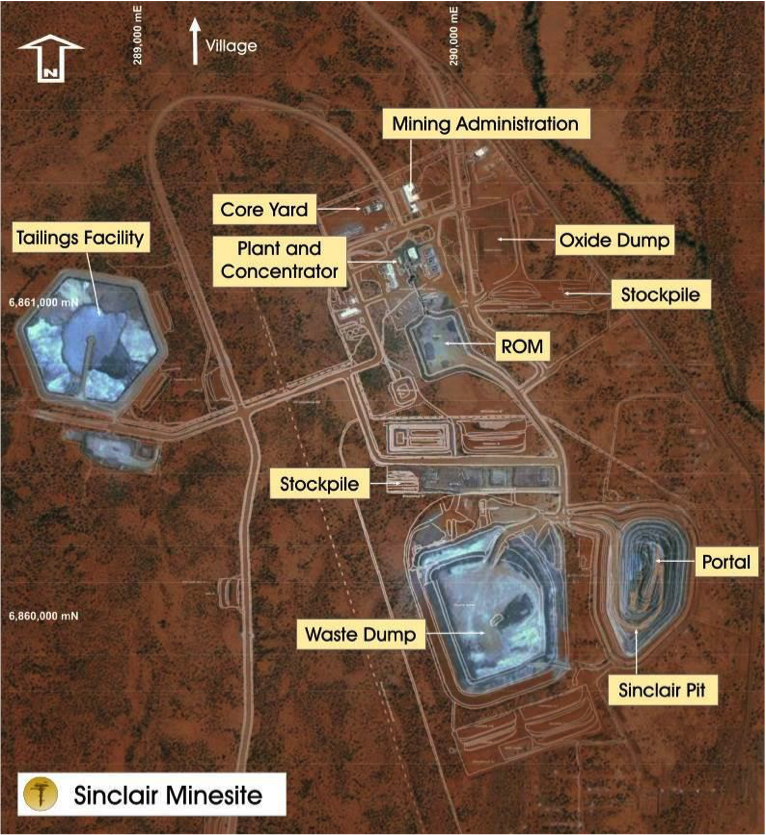
The Sinclair nickel project includes extensive new-near infrastructure including an existing open-cut and underground mine, an on-site 300,000tpa concentrator, sealed airstrip and +200-person accommodation village. The process plant and mine were placed on care and maintenance in August 2013 and have been maintained to a very high standard.
Talisman has provided an update on drilling and exploration activities within its Doolgunna Copper-Gold Projects in Western Australia, where its joint venture partner Sandfire Resources continues to progress a major exploration program – and has recently re-commenced drilling.
Doolgunna Project JV
Extensive programs of detailed air-core drilling were undertaken by Sandfire during Q4 2014 across the Homer (DeGrussa) and Southern Volcanic trends, with a total of 278 holes drilled for 16,780 metres. A total of 21,099 metres of air-core drilling was completed by Sandfire for the 2014 calendar year at Springfield.
Sandfire re-commenced its air-core drilling program at Springfield during early January 2015 and plans to continue drilling activities through the March 2015 Quarter. Final assay results for the geochemical air-core drilling are pending and a detailed interpretation of the geochemical and geological information will begin during H1 2015 once all results have been returned, validated and integrated with historical Talisman drill-hole data.
At the end of December 2014, the first two phases of planned FLEM surveys, consisting of a total of 24 high-powered FLEM loops (each 1,200m by 1,000m), had been completed over the northern extension of the DeGrussa Formation at Homer, as well as the Central Volcanic Corridor and the Monty Prospect. The third and fourth phases of the regional FLEM program re-commenced in early January 2015 and are planned to comprise 25 loops encompassing a large proportion of the Southern mafic volcanic succession. This work program is ongoing and may be completed during the March Quarter 2015.
In addition to the ground EM surveys, a total of 20 RC and diamond drill holes were re-surveyed during Q4 2014 using the latest high-powered (100A) Fluxgate down-hole EM technology. Both the ground FLEM and DHEM data are currently being assessed by geophysical consultants Newexco and will be integrated with the new geochemical and geological data in order to identify DeGrussa-style copper-gold targets for drilling.
Technical Significance
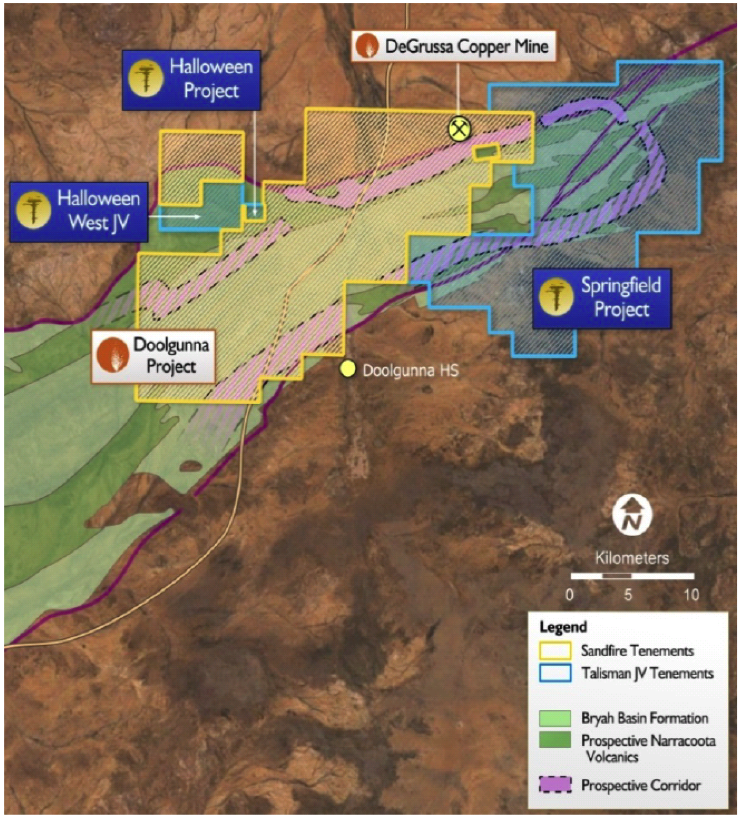
Geological units encountered in drilling included sediments, mafic volcanic sediments, dolerites and basalts, which are interpreted to be consistent with the geology encountered along the DeGrussa corridor on Sandfire’s tenements.
High-powered down-hole DHEM (down-hole electromagnetic surveying) and FLEM (fixed-loop electromagnetic surveying) are key tools in VHMS exploration, and these geophysical techniques have proven to be successful in the DeGrussa environment. Accordingly, they are being extensively deployed by Sandfire across the prospective stratigraphy at the Springfield Project.
Project Background
Sandfire has the right to earn a 70% ownership interest in Talisman’s interests within the Doolgunna region by spending $15 million on exploration across the projects within a 5½-year period. As part of the deal, Sandfire has a minimum expenditure commitment of $5 million within the first two-year period.
Sandfire can then elect to either withdraw from the agreement with no further commitment and no project equity interest, or spend an additional $5 million within a further two-year period in order to earn a 51% interest in the projects. Following this period a joint venture will be formed, with Sandfire holding a 51% interest and Talisman a 49% interest, in the projects. At this point, Sandfire has the option to sole-fund a further $5 million worth of exploration expenditure within a further 18-month period, which will see it acquire a further 19% stake in the projects, taking its total interest to 70%.
The deal is hugely significant as it provides the potential to unlock a new generation of copper-gold discoveries, by combining Sandfire’s emerging geological knowledge (gained from the discovery and development of the high-profile DeGrussa discovery) with Talisman’s extensive Doolgunna datasets and geological knowledge.
Summary
Talisman itself describes the Sinclair deal as being as close to the perfect acquisition as it could have hoped for. It’s hard to argue, as the project has a known deposit extension, huge untapped regional exploration potential, along with established mine infrastructure with two emerging exploration discoveries immediately adjacent to the current mine. With respect to its Doolgunna regional exploration projects, Talisman retains exposure to a potential minimum of $15 million worth of exploration and appraisal expenditure at no cost, being fully-funded by regional neighbor, Sandfire Resources, which possesses deep pockets and the strong incentive of adding to adding to its DeGrussa project life. Sandfire has just kicked off its 2015 field exploration campaign. We therefore retain our Speculative Buy on Talisman Mining around current price levels of $0.155.







